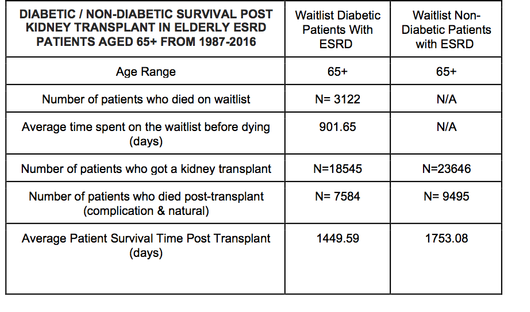Benefits of Transplantation Over Chronic Dialysis in Septugenerian ESRD Patients with Diabetes
Temple University School of Medicine, Philadelphia, PA
Meeting: 2020 American Transplant Congress
Abstract number: 445
Keywords: Kidney transplantation
Session Information
Session Name: Kidney Deceased Donor Selection III
Session Type: Oral Abstract Session
Date: Saturday, May 30, 2020
Session Time: 3:15pm-4:45pm
 Presentation Time: 3:51pm-4:03pm
Presentation Time: 3:51pm-4:03pm
Location: Virtual
*Purpose: In 2016, nearly 125,000 adults in the United States began treatment for end-stage renal disease (ESRD) (i.e., kidney failure requiring dialysis or transplantation). Of these, 44% (approximately 53,000 persons) had diabetes listed as the primary cause of ESRD (ESRD-D). Although maintenance dialysis prevents death from uremia, the life expectancy of patients with ESRD-D is still far below that of the general population. In addition, patient survival in diabetics on dialysis is lower than that seen in nondiabetics with ESRD. Septuagenarians present several challenges for transplantation and diabetics in this age group have long been associated with increased perioperative morbidity and mortality. We sought to analyze the outcomes of transplantation and maintenance dialysis in this demographic.
*Methods: Transplantation rate among non-diabetic and diabetic patients over 65 years was analyzed from 400,000 kidney transplants performed in the US from 1988-2017 using the United Network for Organ Sharing (UNOS) database. Post-transplant overall survival was compared to survival on the waitlist. Analysis was performed using SPSS v26 (IBM). 800,000 patients of all age ranges, diabetic status were included. Waitlist mortality and post-transplant survival was measured.
*Results: A total of 18,545 diabetic and 23,646 non-diabetic patients over the age of 65 were transplanted in the time period studied. Both demographics were transplanted at a similar rate (diabetics at a rate of 6.82% and non-diabetics at a rate of 6.45%). Older diabetic patients had a median survival of 766 days whereas transplantation in these patients improved their overall survival to 1450 days. In the database there was no listed waitlist mortality in non-diabetic patients however we see transplantation in these patients lead to an overall survival of 1753 days. Post-transplant survival was unchanged in patients 65 and older, irrespective of their diabetes status.
*Conclusions: Older diabetic patients with ESRD should not be deemed poor candidates for transplantation based on age. Transplantation improves longevity in these patients when compared to maintenance dialysis. Ensuring ongoing access to transplantation in elderly ESRD patients, irrespective of diabetic status, increases overall longevity.
To cite this abstract in AMA style:
Karhadkar S, Shaik A, Carlo ADi. Benefits of Transplantation Over Chronic Dialysis in Septugenerian ESRD Patients with Diabetes [abstract]. Am J Transplant. 2020; 20 (suppl 3). https://atcmeetingabstracts.com/abstract/benefits-of-transplantation-over-chronic-dialysis-in-septugenerian-esrd-patients-with-diabetes/. Accessed December 19, 2025.« Back to 2020 American Transplant Congress

